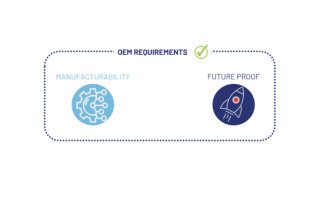Dev Kit Weekly: Thundercomm TurboX AI Kit
September 13, 2019
Video
This week we review the Thundercomm TurboX AI Kit, which is based on the Thundercomm TurboX module, which is based on the Qualcomm SDA845 heterogeneous SoC, which is based on... just kidding. That rabbit hole matters because the SDA845 SoC packs in a ton of processing performance for different kinds of AI workloads, including:
- 8 Kyro CPUs
- An Adreno 630 GPU
- A Hexagon 685 DSP
- A dual 14-bit Qualcomm Spectra 280 image signal processor accompanied by HDR10, HLG, and HEVC hardware encoders/decoders
All of that compute delivers 450 GigaFlops of computing performance, and is supported by 8GB of low-power DDR4 RAM, 64 GB of universal flash storage, and a MicroSD card interface. For those struggling with moving their facial recognition, object detection, or speech processing applications to the edge, this abundance of compute power, high-bandwidth I/O, and memory can surely help.
But what really makes the TurboX board special for AI developers is the software support that comes with it. This starts with the Qualcomm AI Engine, a software package comprised of the Qualcomm Neural Processing SDK and the Android NN API that really fast track the development of facial recognition and object detection applications. The AI engine comes equipped with pre-optimized algorithms and sample source code to help get the prototyping process started.
Developers can train models in AI frameworks like TensorFlow, Caffe, or other development frameworks that are compatible with the ONNX interchange format.
As always, you can win this kit by entering the raffle here: https://opensysmedia.formstack.com/forms/dev_kit_weekly_kit_raffle
If you're interested in learning more about the Thundercomm TurboX AI Kit, visit https://www.thundercomm.com/app_en/product/1536844968290219?index=1&categoryId=category1&tabIndex=1
Questions for @techielew about the kit? Leave a comment.
Please like, subscribe, or follow us online.
See you next week...
Follow Brandon:
Twitter: https://twitter.com/techielew
LinkedIn: https://www.linkedin.com/in/techielew
Follow Embedded Computing Design:
Twitter: https://twitter.com/embedded_comp
LinkedIn: https://www.linkedin.com/groups/1802681/




